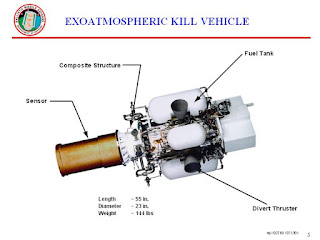Supposedly, this is working now. There was a scathing critique of the system by the GAO in 2014.
But, the way this is suppose to work is for this "kill vehicle" is mounted into the 'nose' structure of the missile that takes it aloft. When deployed out of the nose of the missile, it detects the incoming warheads and destroys them.
I am sure Japan and it's robot culture helped a great deal to perfect the technology. We know it works in Israel in what they call "The Iron Dome." But, sincerely until recent years this has been a "Duck and Cover" military item.
 Spurred by a perceived growing ballistic missile threat (click here) from within the Asia-Pacific region and requests from the United States to support research and development on components of a missile defense system, the Japanese government decided in late 1998 and early 1999 to move forward with joint research and development with the United States on ballistic missile defense (BMD). This book explores both the benefits and potential problems of deploying a BMD system in Japan....
Spurred by a perceived growing ballistic missile threat (click here) from within the Asia-Pacific region and requests from the United States to support research and development on components of a missile defense system, the Japanese government decided in late 1998 and early 1999 to move forward with joint research and development with the United States on ballistic missile defense (BMD). This book explores both the benefits and potential problems of deploying a BMD system in Japan....
The Missile Defense System in Japan is a joint venture with the USA.
August 10, 2015
By Franz-Stefan Gady
South Korea didn't want to escalate the tensions with the North. It is safe to say the North is escalating tensions with the South.
February 7, 2016
It would appear South Korea is the only country in the region with strategic exposure. Considering there are USA subs in the area, I think there is a significant deterrent.
But, the way this is suppose to work is for this "kill vehicle" is mounted into the 'nose' structure of the missile that takes it aloft. When deployed out of the nose of the missile, it detects the incoming warheads and destroys them.
I am sure Japan and it's robot culture helped a great deal to perfect the technology. We know it works in Israel in what they call "The Iron Dome." But, sincerely until recent years this has been a "Duck and Cover" military item.
 Spurred by a perceived growing ballistic missile threat (click here) from within the Asia-Pacific region and requests from the United States to support research and development on components of a missile defense system, the Japanese government decided in late 1998 and early 1999 to move forward with joint research and development with the United States on ballistic missile defense (BMD). This book explores both the benefits and potential problems of deploying a BMD system in Japan....
Spurred by a perceived growing ballistic missile threat (click here) from within the Asia-Pacific region and requests from the United States to support research and development on components of a missile defense system, the Japanese government decided in late 1998 and early 1999 to move forward with joint research and development with the United States on ballistic missile defense (BMD). This book explores both the benefits and potential problems of deploying a BMD system in Japan....The Missile Defense System in Japan is a joint venture with the USA.
August 10, 2015
By Franz-Stefan Gady
On August 7, the U.S. Defense Security Cooperation Agency (DSCA) (click here) announced that the U.S. State Department has approved a possible $1.5 billion sale of two Lockheed Martin Corp Aegis combat systems as well as new anti-submarine warfare equipment to Japan. According to the DSCA press release:
The Government of Japan has requested a possible sale of two (2) ship sets of the MK 7 AEGIS Weapon System, AN/SQQ-89A (v) 15J UWS and CEC. Additional items include associated equipment, training, and support for its Japan Fiscal Year (JFY) 2015 and JFY2016 new construction destroyers (DDGs). The ACS and associated support will be procured over a six (6) to seven (7) year period, as approved by Japan in budgets for JFY2015 and JFY2016.
The weapons deal, likely to be approved by Congress, aims to enhance Japan’s capabilities to defend against a ballistic missile attack. Japan is currently upgrading and modifying all of its Aegis destroyers (the Kongō-class and Atago-class) with the Aegis ballistic missile defense (BMD) system....
South Korea didn't want to escalate the tensions with the North. It is safe to say the North is escalating tensions with the South.
February 7, 2016
South Korea has agreed (click here) to start negotiations with the US on the possible deployment of a missile defense system on its territory, Seoul officials said.
The announcement of the possible deployment of Terminal High Altitude Area Defense (THAAD) was made by Yoo Jeh-seung, South Korean deputy minister for policy at a meeting with Lt. Gen. Thomas Vandal, the commander of USFK's Eighth Army....
Ground-Based Interceptors are emplaced at Fort Greely, Alaska and Vandenberg Air Force Base, California. A total of 30 interceptors were deployed at the end of 2010.
Fire control, battle management, planning, tasking and threat analysis take place via a dual-node, human-in-control interface located in Fort Greely, Alaska and Colorado Springs, Colorado. Warfighters of the 49th Missile Defense Battalion at Fort Greely, Alaska and of the 100th Missile Defense Brigade at Colorado Springs, Colorado. operate the system.
All GMD components communicate through the GMD communications network, a secure data and voice communications system using SATCOM and fiber optic cabling for long-haul communications....